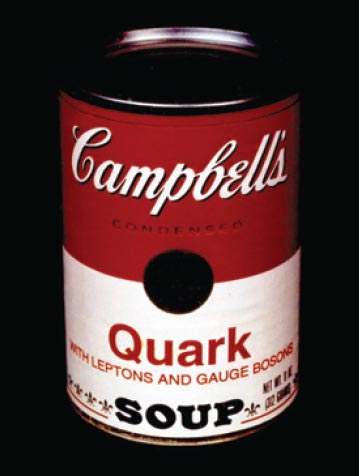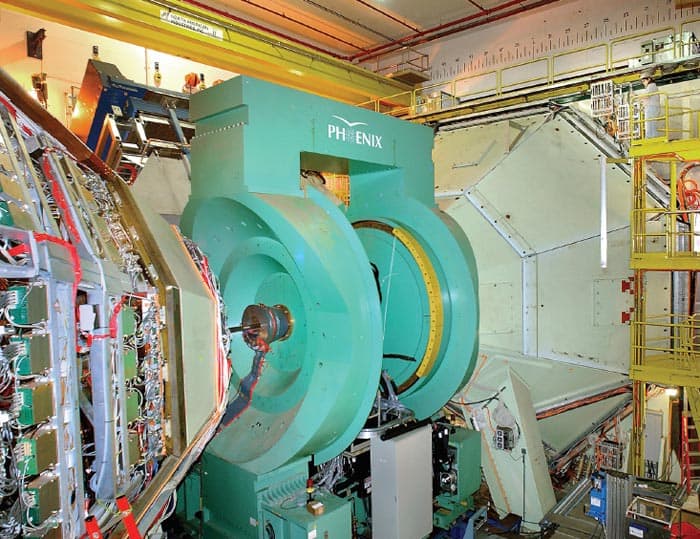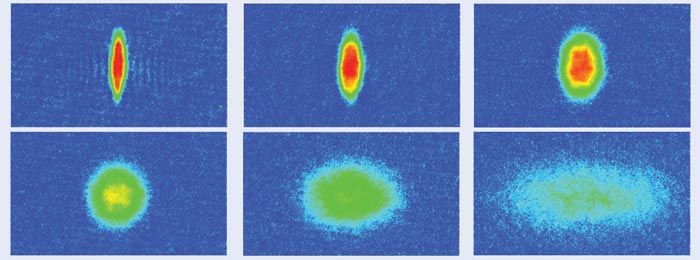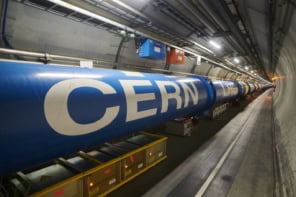An unusual alliance between physicists who study ultrahot plasmas and ultracold atoms is yielding intriguing results – and may even lead to an experimental test for string theory, as Barbara Jacak reveals
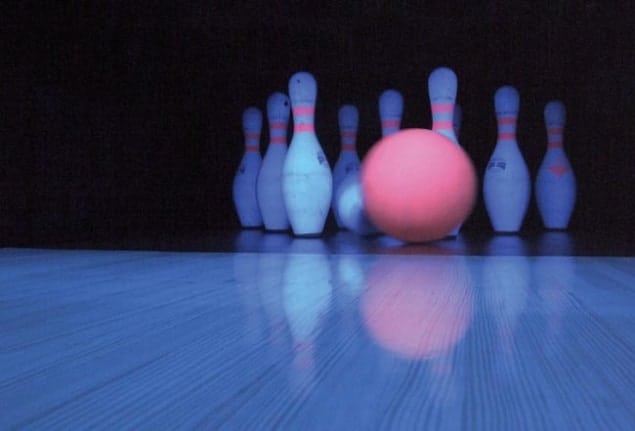
Imagine a bowling ball rolling toward a group of pins. You are an excellent bowler, so the ball is heading for the centre of the group at high speed. Then something strange happens: when the ball reaches the pins, it stops dead. Instead of crashing down, the pins remain frozen in place. What is going on here?
Scientists at the Brookhaven National Laboratory in Upton, New York, are accustomed to unusual collisions. Within the lab’s Relativistic Heavy Ion Collider (RHIC), two beams of gold nuclei moving at 99.99% of the speed of light crash into each other millions of times per second, creating an extraordinarily hot “soup” of particle debris. Two large detectors allow researchers to study this debris (which survives for only 3 × 10–23 s) and thereby reconstruct the behaviour of matter at temperatures of more than 1012 K, almost 100,000 times hotter than the centre of the Sun.
But on some occasions, the outcomes of the collisions surprised both theorists and experimentalists. For example, experiments carried out in the early 2000s showed that the “soup” of matter formed at RHIC – known as a quark–gluon plasma – is extremely opaque to energetic quarks and gluons. Any such particles travelling through this plasma are halted in a short distance and become part of the soup. This quenches the characteristic signal used to detect their emission, effectively causing them to go “missing”. Like the hypothetical bowling ball that stops when it hits the pins, heavy particles with a lot of momentum do not make it out of this plasma. To extend the analogy, it is as if someone tied the bowling pins together with extra-strong rope.
A quark–gluon soup
For quarks and gluons, this heavy-duty “rope” is more properly known as the strong interaction. One of the four fundamental interactions in nature (along with gravity, the weak interaction and the electromagnetic interaction), the strong interaction holds together the quarks making up the protons and neutrons inside atomic nuclei. It is mediated by the exchange of gluons, which work much as photons do in the electromagnetic interaction, but with one enormous difference. Unlike photons, which are more or less oblivious to one other, gluons interact with each other as well as with quarks – a process known as gluon self-interaction. This self-interaction causes the potential between quarks to increase with distance, so more and more energy is required to pull them apart. Eventually this energy pops new gluons out of the vacuum. This process confines quarks inside the normal hadrons detected by experiments, which is why lone unbound quarks have never been observed.
The theory of the strong interaction, known as quantum chromodynamics (QCD), is notoriously complicated (see “Colourful calculations” Physics World December 2006; print edition only). Calculating the properties of matter containing quarks, known as hadronic matter, requires sophisticated mathematical techniques beyond perturbation theory. Still, by solving the QCD equations, we find that the theory predicts that at high energies or temperatures (above 170 MeV or 1012 K) there are so many quarks and gluons that the strong force is “screened”. When this happens, individual quarks and gluons no longer feel the full impact of the force. (A similar effect occurs in a conventional, electromagnetic, plasma, where the presence of free charges can screen the electromagnetic force.) This screening effect causes hadrons to “melt”, liberating their constituents into a plasma of quarks and gluons. Such a plasma may have existed about 1 s after the Big Bang, so investigating these novel plasmas experimentally is an important way of learning more about the early universe.
Experiments at RHIC have shown that the hot matter behaves more like a liquid soup of quarks and gluons than like a nearly ideal gas. In this liquid system, multiple particles exert forces on one another simultaneously, and the quark-gluon plasma flows in a coordinated way. More precisely, the experiments show that the plasma flows in an elliptic fashion, spreading more rapidly along one axis than the other. Such behaviour can be quantitatively calculated using the laws of hydrodynamics, and the results reproduce the magnitude of the flow quite well – but only if we assume that the system starts in a plasma phase with a very tiny ratio of viscosity η to entropy density s.
The term “viscosity” is best understood as the measure of a fluid’s ability to sustain a wave and transport momentum. Hence, low-viscosity fluids absorb particles and transport disturbances easily. Transport properties of materials are determined by both the viscosity and the density of particles. Consequently, we use the ratio of viscosity to entropy density, which measures the disorder and particle number. For example, the efficient momentum transport observed in quark–gluon plasmas implies that neighbouring fluid elements “talk” to each other; in other words, the coupling between them is strong. Such strong coupling also explains the fluid’s opacity, as the traversing particles collide with more than one gluon or quark at a time.
But one of the most intriguing consequences of the plasma’s low viscosity is that its η/s ratio is near the value that string theorists have calculated must be the lower limit for a liquid: that is, 1/4π. This is about 380 times smaller than the value for water under normal conditions and nine times lower than that for liquid helium. The vanishing viscosity-to-entropy ratio makes the liquid nearly “perfect”, i.e. able to flow with no resistance whatsoever.
Cold cousins
In the aftermath of the discoveries at RHIC (see, for example, K Adcox et al. 2005 Nucl. Phys. A757 184), there has been a raging debate about just what exactly is interacting inside the quark–gluon plasma. It is not clear whether the matter consists of individual gluons, pure gluonic fields or perhaps multi-gluon objects that continually split and re-form. The task at RHIC now is to upgrade the accelerator and experiments to provide new probes of the matter to differentiate between these scenarios.
In the meantime, our efforts to solve this nuclear-physics problem are benefiting from insights gained in other areas of physics. Although a quark–gluon plasma is an exotic substance in many ways, its liquid properties are similar to those of other strongly correlated systems, where one cannot use the behaviour of a few particles to work out how a large number will behave en masse. Such systems include warm, dense electromagnetic plasmas, which have liquid and even crystalline phases even though they are plasmas. Strongly correlated condensed matter such as high-Tc superconductors also display liquid behaviour and phase transitions (see “The strong-correlations puzzle” Physics World June 2009 pp32–37, print edition only) . Most intriguingly of all, so does some of the coldest matter on Earth.
At about the same time that the researchers at RHIC began heating nuclei to unprecedentedly high temperatures, atomic physicists at Duke University were cooling lithium atoms down to a fraction of a degree above absolute zero. In these experiments, the atoms were first laser-cooled to about 150 µK, then placed in a “bowl of light” formed at the focus of a carbon-dioxide laser beam. By gradually reducing the depth of the bowl, the researchers allowed more energetic atoms to evaporate away, thus producing a supercooled sample of atoms at 10–7K.
Among the many beautiful features of these experiments is that, unlike the plasmas created at RHIC, these ultracold atomic systems live for a relatively long time – several tens of seconds under some circumstances. This means that the cloud of atoms can be reproduced and photographed multiple times, and be released from the trap as well as set to rotate. Another major advantage is that experimentalists can control the transformation of the ultracold lithium atoms from a weakly coupled to a strongly coupled system simply by changing the surrounding magnetic field, using a phenomenon known as a Feshbach resonance.
Amazingly, the team at Duke found that when the strongly coupled cloud was released from the trap, the cold atoms flowed with the same kind of elliptical pattern as observed at RHIC. Further experiments allowed the Duke researchers to measure the entropy of the atom cloud and to estimate its viscosity by observing the rotation rate of the lithium gas as it is allowed to expand. This measurement showed that the viscosity-to-entropy ratio is just as small in the ultracold system as it is in the ultrahot quark–gluon plasma. Naively, one would not expect such different systems to exhibit the same behaviour – but they do.
The string connection
While nuclear and atomic physicists were pondering how to reconcile these observations, a third group of researchers – string theorists – weighed in too. The connection came to light when the theorists were investigating what happens to gravity near tiny black holes, where quantum-mechanical effects matter. Understanding these quantum black holes requires combining the theory of general relativity with quantum mechanics, and one important payback for this effort is the ability to compute the minimum possible viscosity-to-entropy ratio in quantum matter.
Since black holes are thought to radiate, they act like bodies possessing temperature and entropy, where their entropy depends on their area. String theory supplies a quantum-gravity description of the black hole’s internal structure – one that allows calculations of the physics of the black hole to be carried out using a theory known as the holographic principle. These calculations involve building a mathematical “box” around the black hole. Our normal world lies on the surface of that box, and our normal four dimensions (time plus the three spatial dimensions) are supplemented by an extra, fifth dimension that dangles inside the box and connects to the black hole. The strong gravitational effects of the black hole manifest themselves in this fifth dimension.
Remarkably, string theorists were able to connect this esoteric system with our normal 3 + 1 dimensional world and interpret the viscous flow of strongly coupled matter as the motion of the string dangling in the fifth dimension (see, for example, P Kovtun, D T Son and A O Starinets 2005 Phys. Rev. Lett. 94 111601). This analogy provided a new mathematical tool, which was promptly used to compute the value of η/s in matter the constituents of which are too strongly coupled to be calculated using more conventional means.
The interactions among the hot quarks and gluons at RHIC or the cold lithium ions at Duke can be described as strings in the extra dimension. In addition to the very low viscosity/entropy observed, other properties of strongly coupled systems can be calculated. For example, the transport of energy and the propagation of sound waves are currently being studied in both string theory and in experiments at RHIC through correlations of the detected particles.
This development is extremely exciting as it finally allows experimentally testable predictions to be made from string theory. It is also helpful for experimentalists studying very complex novel liquids. Fresh efforts in this field are beginning to exploit the idea that gravity can be seen as a “dual” for such systems, where the term “dual” basically refers to a system or process that can be described equally well by two theories that, despite their differences, predict the same observable result. Such gravity duals are now being investigated for gap-less superconductors, quantum-critical phase transitions between insulators and superfluids, as well as other quantum-critical points of interest in condensed-matter physics.
Such deep and varied links to seemingly unrelated areas of physics were not something researchers expected to find when RHIC began colliding gold ions earlier this decade. Yet perhaps we should not have been surprised. After all, an impenetrable “soup” of quarks and gluons that flows like a liquid is a fairly remarkable thing in itself. The connections between this system and cold atoms, string theory and superconductors are sure to reveal more surprises in the future.
